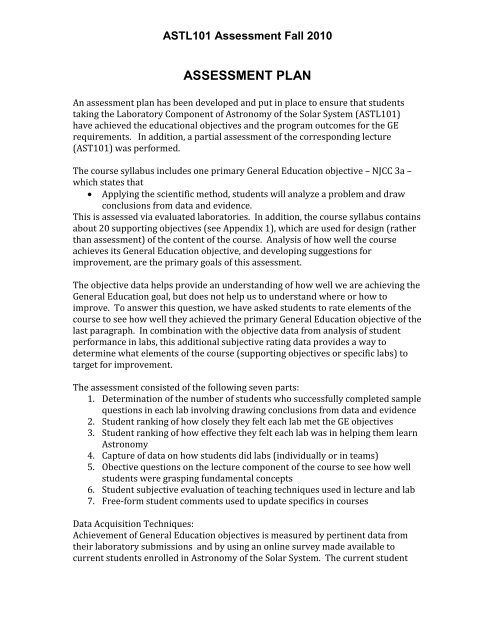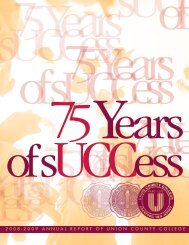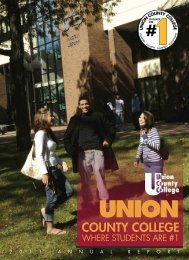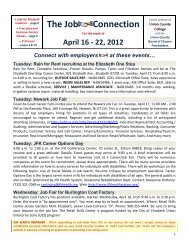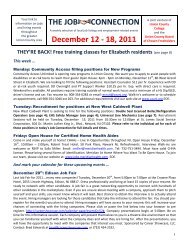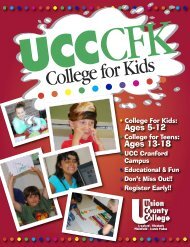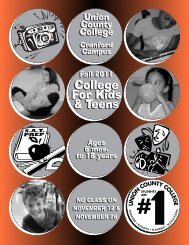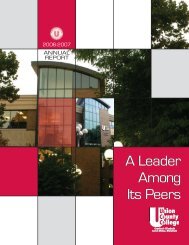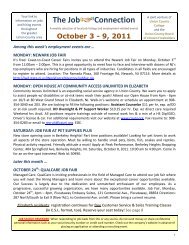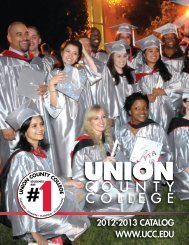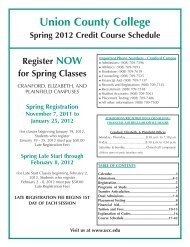Exhibit 147
Exhibit 147
Exhibit 147
Create successful ePaper yourself
Turn your PDF publications into a flip-book with our unique Google optimized e-Paper software.
ASTL101 Assessment Fall 2010<br />
ASSESSMENT PLAN<br />
An assessment plan has been developed and put in place to ensure that students<br />
taking the Laboratory Component of Astronomy of the Solar System (ASTL101)<br />
have achieved the educational objectives and the program outcomes for the GE<br />
requirements. In addition, a partial assessment of the corresponding lecture<br />
(AST101) was performed.<br />
The course syllabus includes one primary General Education objective – NJCC 3a –<br />
which states that<br />
• Applying the scientific method, students will analyze a problem and draw<br />
conclusions from data and evidence.<br />
This is assessed via evaluated laboratories. In addition, the course syllabus contains<br />
about 20 supporting objectives (see Appendix 1), which are used for design (rather<br />
than assessment) of the content of the course. Analysis of how well the course<br />
achieves its General Education objective, and developing suggestions for<br />
improvement, are the primary goals of this assessment.<br />
The objective data helps provide an understanding of how well we are achieving the<br />
General Education goal, but does not help us to understand where or how to<br />
improve. To answer this question, we have asked students to rate elements of the<br />
course to see how well they achieved the primary General Education objective of the<br />
last paragraph. In combination with the objective data from analysis of student<br />
performance in labs, this additional subjective rating data provides a way to<br />
determine what elements of the course (supporting objectives or specific labs) to<br />
target for improvement.<br />
The assessment consisted of the following seven parts:<br />
1. Determination of the number of students who successfully completed sample<br />
questions in each lab involving drawing conclusions from data and evidence<br />
2. Student ranking of how closely they felt each lab met the GE objectives<br />
3. Student ranking of how effective they felt each lab was in helping them learn<br />
Astronomy<br />
4. Capture of data on how students did labs (individually or in teams)<br />
5. Obective questions on the lecture component of the course to see how well<br />
students were grasping fundamental concepts<br />
6. Student subjective evaluation of teaching techniques used in lecture and lab<br />
7. Free-form student comments used to update specifics in courses<br />
Data Acquisition Techniques:<br />
Achievement of General Education objectives is measured by pertinent data from<br />
their laboratory submissions and by using an online survey made available to<br />
current students enrolled in Astronomy of the Solar System. The current student
ASTL101 Assessment<br />
population enrolled includes 5 in-class sections offered in Cranford and Elizabeth<br />
and 4 online sections.<br />
This survey asks our students to evaluate each of the individual laboratory exercises<br />
and includes a limited number of multiple-choice questions about material covered<br />
in the lectures and laboratories. In addition we will correlate the students<br />
understanding of concepts being tested in the laboratory exercises with the<br />
students’ answers to a number of short essay questions given in a subset of the<br />
laboratory exercises.<br />
Time Scale<br />
This survey will be conducted before the present term ends (12/2010). The survey<br />
will be offered for the next 2 or 3 years to evaluate changes made to the course.<br />
Action<br />
We will evaluate what needs to be changed or updated in our laboratory offerings.<br />
We will then use our survey over the next 2 or 3 years to evaluate the outcome of<br />
our updated laboratory offerings.<br />
- 2 -
ASTL101 Assessment<br />
SUMMARY OF MAJOR FINDINGS AND<br />
CORRECTIVE ACTIONS<br />
This section gives a summary of major findings, along with actions being taken to<br />
address those findings. Specifics are detailed in the sections below.<br />
1. In lab, the overall percent of students with correct answers is 63%, short of<br />
our goal of 70%.<br />
Corrective action: In Fall 2011, (the next major time AST101 is offered inclass),<br />
we will implement pre-tests for several labs, requiring students to<br />
answer several questions on the lab’s concepts before the remainder of the<br />
lab is made available to them. This will be trialed at first only for in-class labs<br />
– if successful, it will be extended to web labs.<br />
2. Students consider lab OP17 as not supporting GE objectives nor helping them<br />
learn Astronomy.<br />
Corrective action: OP17 was replaced by OP11 immediately after we received<br />
feedback from several sections of students. The replacement, OP11, achieved<br />
student rating scores consistent with other labs.<br />
3. Students achieved an abysmally low score (29%) on a very fundamental<br />
question – how many stars are there in the Solar System.<br />
Corrective action 1: We felt that the problem was that student’s knew the<br />
correct answer here, but just were trying to complete the questionnaire<br />
quickly and weren’t fully reading the question. We tested this hypothesis by<br />
re-asking the same question in class again on paper, but asking the students<br />
to read the questions carefully. Results improved from the original 29% to<br />
68.7 This is still short of our target of 70% .<br />
Corrective action 2: This question is also asked in AST102 (Spring), so we‘ll<br />
be taking action in Spring to see how to improve scores. Each instructor will<br />
show a short video on the sizes of objects in the Universe at the beginning of<br />
the last third of the course, reinforcing material already taught in the first<br />
lesson, but perhaps forgotten. And we’ll add a note to the assessment<br />
question to “read the question carefully”.<br />
Reassessment in Spring 2011: This has been partially successful – in<br />
reassessment the following semester, 70.4% of students answered this<br />
correctly. While meeting our target, it is only a small increase from the<br />
results obtained by corrective action a (above). To try to improve this<br />
further, we have modified two sets of lecture notes to explicitly require a<br />
video on the scales of the universe during the last third of each astronomy<br />
lecture course.<br />
- 3 -
Part 1:<br />
ASTL101 Assessment<br />
DETAILED ASSESSMENT RESULTS<br />
There are 12 to 20 questions in each of the 12 labs offered during the semester.<br />
Students are given a goal to complete 10 labs. We chose 10 questions from 8 of the<br />
12 labs. The answers to these questions are based on the observations and data<br />
taken by the student. The questions and answers can be found in Appendix 2 at the<br />
end of this document.<br />
Table 1: Student Results.<br />
In-class students work in teams of 2 or 3 members, online students work<br />
individually<br />
OP17 was replace with OP11<br />
* Online only<br />
** One section only as new lab<br />
CONCLUSION<br />
Laboratory Title Question # Number of<br />
Students &<br />
Teams<br />
completing<br />
lab<br />
% of<br />
Students<br />
with correct<br />
answers<br />
OP1 Starry Night Tutorial 11 93 66<br />
OP3 Astronomical Coordinates 21 91 73<br />
OP15 Kepler's Third Law 14 103 64<br />
Mass of Earth 16 37* 68<br />
OP17 Parallax 13 55 24<br />
OP17 Parallax 19 55 31<br />
OP11 Solar Eclipses 20 14** 85<br />
OP11 Solar Eclipses 38 14** 46<br />
OP12 Phases of Venus 15 101 90<br />
OP12 Phases of Venus 16 101 39<br />
OP14 Mars and its Moons 6 91 38<br />
Sky Charts 12 120 68<br />
Average (not using OP17) 64<br />
Our goal is to have 70% of the students answer each question correctly. From the<br />
results in Table 1, the students only met this goal on 3 questions.<br />
Lab 17, Parallax, had the lowest success rate, and was also reported by students as<br />
ineffective both in meeting GE requirements and in teaching astronomy (see parts 2<br />
- 4 -
ASTL101 Assessment<br />
and 3 below). It was immediately replaced by lab, OP11, Solar Eclipses, which had a<br />
large improvement with the single class that completed this lab.<br />
Four additional questions were close to our goal, having greater than 60% correct<br />
answers. The results of one of the two questions on each of labs OP11 and OP12,<br />
and the one question on OP14 are of concern. We plan to look into these seven<br />
questions in more detail to understand how to improve our students’ performance<br />
in these labs.<br />
Part 2:<br />
In this part, students were reminded of the contents of each lab, then asked how<br />
well they felt the lab met the General Education objective being measured.<br />
Appendix 3, questions 1-10 provide specific questions asked for each of the 10 labs.<br />
A typical question follows the following format:<br />
• In Lab OP1, Starry Night Tutorial, you learned how to use features of Starry<br />
Night, and then used the features of Starry Night on your own to determine<br />
what continent was visible to Neil Armstrong and Buzz Aldrin when they<br />
landed on the Moon. Do you feel that this lab met the objective of "Applying<br />
the scientific method, students will analyze a problem and draw conclusions<br />
from data and evidence"? If you did not do this lab, please leave your answer<br />
blank.<br />
The scale is<br />
1 = strongly agree; 2 = agree, 3 = neutral, 4 = disagree, 5 = strongly disagree.<br />
Results are as follows:<br />
- 5 -
ASTL101 Assessment<br />
From the data, it is clear that lab OP17 was showing a significantly lower score than<br />
other labs. Since not all class sections had completed OP17 at the time of the<br />
evaluation, we replaced OP17 with lab OP11. Students who completed OP11 gave<br />
OP11 a much more favorable rating, in line with the average ratings for other labs.<br />
Part 3:<br />
This was similar to part 2, except that it asked “how effective did you feel each lab<br />
was in helping you learn astronomy? It includes all the labs for which conclusions<br />
had to be drawn from data (as in part 2), as well as laboratories which help students<br />
learn astronomy but do not provide objective data (e.g. observatory visits).<br />
- 6 -
ASTL101 Assessment<br />
Again, OP17 is seen as weaker than other labs in helping students learn astronomy.<br />
Its replacement, OP11, scored among the better OP labs.<br />
Students were also asked to provide free-form comments on this part – only 5<br />
comments were obtained, with one student claiming to not get any information out<br />
of the parallax lab (OP17).<br />
- 7 -
ASTL101 Assessment<br />
Part 4:<br />
We captured additional data on how each student did the lab (individually or in a<br />
team) in case we wish to do a subsequent analysis on the impact of teaming on lab<br />
performance. We also contacted students who had withdrawn from the course or<br />
stopped attending to see if they would provide reasons for discontinuing the course.<br />
Unfortunately we had no responses.<br />
Part 5:<br />
We asked several objective questions on the lecture component of the course to see<br />
how well students were grasping fundamental concepts.<br />
Question<br />
% of Students with correct answers<br />
How many stars are there in our Solar<br />
System 29%<br />
About how many moons are there in our<br />
solar system? 53%<br />
It takes light 8 minutes to travel from the<br />
Sun to the Earth. About how long (in 36%<br />
minutes) would it take a radio message<br />
to travel from the Earth to Pluto (a radio<br />
wave travels at the speed of light). Select<br />
the best answer<br />
If a planet in a solar system is made of<br />
rock and metal, but has no planet-wide 55%<br />
magnetic field, you would assume that<br />
- 8 -
ASTL101 Assessment<br />
These results are far lower than expected, and indicate either a lack of<br />
understanding of the material, student’s being unprepared to answer analytic<br />
questions during an informal assessment, or not understanding the specific wording<br />
of the question.<br />
For question 1, we asked students, “How many stars are there in the Solar System”,<br />
for which the possible answers were a) none, b) one (the Sun, the correct answer),<br />
c) hundreds, or d) billions, only 31 students out of 107 (29%) answered correctly,<br />
with 72 students (67%) answering “billions”. Given the high number of students<br />
answering “billions”, we thought that some students might not be taking note of the<br />
words “in the Solar System”, and re-asked this question at the beginning of the<br />
course final exam, about one week after the deadline for the online<br />
assessment. Students in different exam sessions were given slightly different<br />
instructions, explained in the following:<br />
• In group 1 (our control group) we re-asked the identical question, with no<br />
special verbal instructions. During the original assessment, 3 out of 19<br />
students (16%) in this group had answered correctly. On reassessment, 4<br />
out of 19 (21%) answered correctly, an insignificant difference for this small<br />
sample size.<br />
• In group 2, during reassessment we told the students to read the question<br />
carefully. During the original assessment, 9 out of 26 students (35%) in this<br />
group had answered correctly. On reassessment, 16 out of 26 (62%)<br />
answered correctly. Just the admonition to read had a major effect on<br />
student performance, boosting performing for this group of 26 students by<br />
almost a factor of 2.<br />
• In group 3, during reassessment we changed the wording of the question to<br />
“How many stars are there in the Solar System, not anywhere else”. During<br />
the original assessment, 16 out of 53 students (30%) in this group had<br />
answered correctly. On reassessment, 34 out of 53 (64%) answered<br />
correctly, a very similar result to group 2.<br />
The data above clearly shows that the way a question is worded (and consequently<br />
interpreted) can result in major shifts in results. For the purposes of final results,<br />
we are combining the reassessment scores for group 2 (16 out of 26), group 3 (34<br />
out of 53), and students who took the reassessment with group 2 or 3 wording but<br />
never took the original assessment (42 out of 55). That gives a total of 92 correct<br />
responses out of 134, or 68.7% of all students.<br />
Part 6:<br />
Students were asked to evaluate teaching techniques used in lecture and in lab. Text<br />
and scale of each question is shown in Appendix 3. Results are as follows:<br />
- 9 -
ASTL101 Assessment<br />
For lecture, students indicated wanting to see more open book quizzes and fewer<br />
closed book quizzes, an expected result. Results for labs were inconclusive and<br />
imply that we have a suitable mix.<br />
On question 23 – new labs, the only strong item was “learning to use a telescope”.<br />
As a result of this assessment, we have purchased 10 portable electromechanical<br />
telescopes and are developing a telescope lab, with planned availability for Fall<br />
2011.<br />
Part 7:<br />
Free-form student comments were solicited. These are not used as part of the<br />
formal assessment process, but are reviewed each semester prior to course<br />
preparation to see if any specifics in courses should be changed.<br />
- 10 -
ASTL101 Assessment<br />
APPENDIX 1<br />
GENERAL EDUCATION AND SUPPORTING OBJECTIVES<br />
The Course Objective pertaining to lab component of ASTL101:<br />
♦ Applying the scientific method, students will obtain data in lab, and then<br />
apply concepts learned in lecture and lab to solving problems posed in lab.<br />
♦ Improve computer proficiency by utilizing PC planetarium software to<br />
perform labs and identify/analyze objects in the sky.<br />
GE Program Outcomes Student Learning – Course<br />
Outcomes<br />
Specific objectives relating to scientific knowledge and reasoning:<br />
3a. Applying the scientific Applying the scientific method,<br />
method, students will students will obtain data in lab,<br />
analyze a problem and and then apply concepts learned<br />
draw conclusions<br />
in lecture and lab to solving<br />
from data and evidence. problems posed in lab<br />
Assessment of<br />
Outcomes<br />
Evaluated<br />
laboratories<br />
ASSESSMENT CRITERIA FOR GENERAL EDUCATION OBJECTIVES UNDER SCIENCE<br />
AND TECHNOLOGY FOR ASTRONOMY LABORATORY<br />
GOAL: SUDENTS WILL USE SCIENTIFIC METHODS AND KNOWLEDGE WITH THEIR<br />
OBSERVATIONS AND DATA OBTAIN FROM THE COURSE LABORATORIES TO<br />
EXPLAIN AND VERIFY CURRENTS ASTRONOMY THEORIES AND HYPOTHOSIS.<br />
Students will be able to demonstrate an understanding of the underlying physical<br />
principles governing the Earth and the Solar System.<br />
OTHER OBJECTIVES:<br />
1) To develop a general understanding in using scientific method of applying<br />
their observations and data to the verification of a theory or hypothesis.<br />
2) Students will be able to demonstrate the taking of data and using this data to<br />
make objective conclusions.<br />
3) Students will formulate and evaluate possible solutions to problems, and<br />
select the solutions that are consent with their data and understanding.<br />
ADDITIONAL OBJECTIVES:<br />
1) Students will comprehend and evaluate what they read and hear.<br />
2) Students will state and evaluate the views and findings of others as part of<br />
some of the assigned labs.<br />
- 11 -
ASTL101 Assessment<br />
3) Students will write and speak clearly and effectively in standard American<br />
English.<br />
4) 4. Students will formulate and evaluate possible solutions to problems.<br />
5) Students will recognize the weakness of some proposed hypotheses because<br />
of the lack of sufficient observations, experiments and data.<br />
PARTICULAR COURSE OBJECTIVES<br />
Upon completion of this course the student should be able to:<br />
1) Demonstrate knowledge of the components of the solar system, including<br />
planets, dwarf planets, Sun, satellites, asteroids, meteors, comets<br />
2) Identify solar system regions including the asteroid belt, Kuiper belt, and<br />
Oort cloud<br />
3) Understand basic physics concepts pertaining to solar system astronomy,<br />
including scientific method, concepts of measurement, density, mass,<br />
Newton’s laws, rotational motion, and heat transfer<br />
4) Understand basic geology concepts pertaining to solar system astronomy,<br />
including volcanism, plate tectonics, and the internal structure of the Earth<br />
5) Understand the difference between discovery and scientific models.<br />
Students will learn how scientists use experimental evidence to<br />
confirm/falsify a theory. Students will be asked to evaluate conflicting<br />
theories in in-class discussions based on available data. Discussion is held on<br />
geocentric vs. heliocentric views of the solar system<br />
6) Applying the scientific method, students will obtain data in lab, and then<br />
apply concepts learned in lecture and lab to solving problems posed in lab.<br />
7) Gain an expanded awareness of his/her rights and responsibilities as citizens<br />
of a world community through discussion of topics such as global warming,<br />
the popular misuse of words such as “theory” and their impact on public<br />
understanding of scientific method<br />
8) Put astronomic/physics discoveries into historical perspective<br />
9) Understand how science affects society, from concepts such as the calendar<br />
and Earth’s place in the Universe.<br />
10) Demonstrate internet literacy by researching topics on the web and creating<br />
a research paper in a topic in Astronomy<br />
- 12 -
ASTL101 Assessment<br />
11) Improve computer proficiency by utilizing PC planetarium software to<br />
perform labs and identify/analyze objects in the sky.<br />
12) Learn through out-of-class experiences, including attending planetarium<br />
shows, observatory visits, outside technical talks, and at-home sky<br />
observation.<br />
- 13 -
ASTL101 Assessment<br />
APPENDIX 2<br />
LAB QUESTIONS USED FOR QUANTITATIVE MEASUREMENTS<br />
The following are the set of questions and answers from ASTL101 Labs used for this<br />
assessment:<br />
Laboratory OP1<br />
Question 11. Does the comet move relative to the stars or does it remain stationary?<br />
(Moving relative to the stars means that, as time moves on, the comet slowly<br />
changes its position against those stars.)<br />
Answer: The comet moves relative to the stars.<br />
OP3<br />
Question 21. a) What is the altitude of the North Celestial Pole for an observer at<br />
the North Pole of the Earth?<br />
b) What is the declination of the North Celestial Pole?<br />
c) Does your answer to part b depend upon your observing location on the Earth?<br />
d) Why or why not?<br />
Answer: a) 90° b) 90° c) No d) Since declination uses the celestial equator rather<br />
than the horizon as reference plane, the declination of the North Celestial Pole does<br />
NOT change when an observer changes location on the Earth.<br />
OP10<br />
Question 35: Notice that the horizon does not get in the way at any time during this<br />
sequence. (That is, the Earth always remains in about the same position in the lunar<br />
sky). Can you explain why?<br />
Answer: The Moon’s rotational period is the same as its orbital period, and so the<br />
Earth will remain in approximately the same position in the lunar sky throughout its<br />
Orbit.<br />
OP15<br />
Question 14: From your answers to the above questions, is there any clear<br />
synchronicity between the orbital periods of Io, Europa, and Ganymede? Explain<br />
your answer (don't just answer yes or no).<br />
Answer: The orbital periods of the satellites Io, Europa, and Ganymede are in the<br />
ratio 1:2:4 if your data above was correct. If one or more of your measurements<br />
were incorrect, I looked at this answer by hand to determine whether you should<br />
have answered this yes or no.<br />
Mass of Earth<br />
Question 16: Would T (period of pendulum) be larger or smaller on the Moon?<br />
- 14 -
ASTL101 Assessment<br />
Answer: The period of the pendulum is inversely proportional to the square root of<br />
the acceleration due to gravity. The period is larger because the force of gravity on<br />
the Moon is less than Earth.<br />
OP11<br />
Question 20: Is it possible for more than two eclipse seasons to occur in the<br />
duration of a calendar year? (Hint: An eclipse year is shorter than a solar year.)<br />
Yes or No and how?<br />
Answer: Yes, if an eclipse season occurs in the first 19 days of the year, the next<br />
eclipse season will occur about 173 days later in June, and the following eclipse<br />
season will occur in December of the same calendar year.<br />
Question 38: What type of eclipse occurs, as seen from this location, within the<br />
darkest part of the Moon’s shadow?<br />
□ Partial □ Annular □ Total<br />
Answer: Annular<br />
OP12<br />
Question 15: Do your observations support the geocentric or the heliocentric<br />
theory of the universe? Note I'm not looking here for which is the right theory, I'm<br />
asking you which one is supported based on your results in previous questions.<br />
a. Geocentric Theory b. Heliocentric Theory<br />
Answer: The results support the heliocentric theory.<br />
Question 16: Which specific observations support your answer to the previous<br />
question?<br />
Answer: As discussed in the introduction, Venus shows a full range of phases only in<br />
the heliocentric theory. In the geocentric theory, Venus should always appear as a<br />
crescent. Moreover, in the heliocentric theory, Venus should appear largest at<br />
crescent phase, and smallest at full phase, as observed.<br />
OP14<br />
Question 6. Why does Phobos appear very faint or invisible when it emerges<br />
beyond the planet’s limb, and what causes Deimos to appear to wink out at a certain<br />
position just beyond the planet, on every one of their orbits?<br />
Answer: These moons move into the shadow of Mars during part of their orbital<br />
paths.<br />
OP17<br />
Question 11: Question 11: Assume that you are using equipment for measuring<br />
parallax that can detect angular displacements as small as one-half of an arcsecond<br />
(0.5”) and use the diameter of the Earth as 12,757 km.<br />
a) What is the distance, in kilometer, to the farthest object for which you could<br />
measure parallax shift?<br />
b) What is this distance expressed in AU? [Hint: use eq. 3]<br />
- 15 -
ASTL101 Assessment<br />
c) What is the farthest planet in the solar system for which you could measure<br />
parallax, using this diameter of the Earth?<br />
Answer: 11. A) 5.26 x 109 km, B) leave blank, C) Neptune<br />
Question 20: What distance did you calculate from the parallax shift of: a) Europa,<br />
b) Iapetus, c) Miranda, d) And Nereid?<br />
Answer: 20. A) 5.602 AU, accept 5.5 to 5.7”; B) 9.067 AU, accept 9.0 to 9.2 AU; C)<br />
20.94 AU, accept 20. to 21. AU; D) 30.75 AU, accept 30. to 31. AU<br />
SkyCharts<br />
Question 12. Look to the south to see Jupiter – it will be the brightest object in the<br />
sky. If it is so bright, why isn’t it in your sky map? _______________<br />
Answer: Jupiter is a planet and it “wonders” with respect to the stars.<br />
- 16 -
ASTL101 Assessment<br />
APPENDIX 3<br />
TEXT OF QUALITATIVE ASSESSMENT OFFERED TO STUDENTS<br />
Objectives<br />
Every few years, I do a complete course assessment to obtain student input which helps me<br />
revise and update the course. Please note that you are being given one point extra credit for<br />
completing this assessment. My expectation in return is that you will spend a reasonable<br />
amount of time to provide thoughtful answers.<br />
One of the stated objectives of ASTL101 is:<br />
• Applying the scientific method, students will analyze a problem and draw<br />
conclusions from data and evidence.<br />
We do this during lab, in which I ask you to take data, and then come to come to conclusions<br />
from that data. For the following labs, please identify how well you feel each lab achieves this<br />
objective. I have given you a brief reminder of what each lab is about, but if you have done the<br />
lab and don't remember, please take a moment to look at the lab again to refresh your memory -<br />
this is really important as your evaluations will affect the lab choices available to students for<br />
the next several years. If you have not done some of the following labs, please leave those labs'<br />
entries blank. (Note OP17 and OP11 are each only available in selected sections)<br />
1. In Lab OP1, Starry Night Tutorial, you learned how to use features of Starry Night, and<br />
then used the features of Starry Night on your own to determine what continent was<br />
visible to Neil Armstrong and Buzz Aldrin when they landed on the Moon. Do you feel that<br />
this lab met the objective of "Applying the scientific method, students will analyze a<br />
problem and draw conclusions from data and evidence"? If you did not do this lab, please<br />
leave your answer blank.<br />
Strongly<br />
Strongly agree Agree Neutral Disagree<br />
disagree<br />
2. In Lab OP3, Astronomical Coordinate Systems, you learned the difference between<br />
Horizontal Coordinates (azimuth and altitude) and Equatorial Coordinates (right<br />
ascension and declination). Do you feel that this lab met the objective of "Applying the<br />
scientific method, students will analyze a problem and draw conclusions from data and<br />
evidence"?<br />
Strongly<br />
Strongly agree Agree Neutral Disagree<br />
disagree<br />
- 17 -
ASTL101 Assessment<br />
3. In Lab OP10, The Moon's Motions and Phases, you learned about the different phases of<br />
the moon, and noted that the Moon's "horns" always point away from the Sun. Do you feel<br />
that this lab met the objective of "Applying the scientific method, students will analyze a<br />
problem and draw conclusions from data and evidence"?<br />
Strongly<br />
Strongly agree Agree Neutral Disagree<br />
disagree<br />
4. In Lab OP15, Kepler's Third Law, you measured the revolutionary period of each of<br />
Jupiter's moons and the distance of each moon from Jupiter, calculated k = P 2 /a 3 . for each<br />
moon, and compared values of k to see if the moons of Jupiter obey Kepler's law. Do you<br />
feel that this lab met the objective of "Applying the scientific method, students will<br />
analyze a problem and draw conclusions from data and evidence"? If you did not do this<br />
lab, please leave your answer blank<br />
Strongly<br />
Strongly agree Agree Neutral Disagree<br />
disagree<br />
5. In the Mass of the Earth lab, you measured the length and period of a pendulum and<br />
used those measurements to calculate the mass of the Earth. Additionally, the lab<br />
discussed precision of numbers (how many decimal points you are entitled to) and<br />
sources of error. Do you feel that this lab met the objective of "Applying the scientific<br />
method, students will analyze a problem and draw conclusions from data and evidence"?<br />
If you did not do this lab, please leave your answer blank.<br />
Strongly<br />
Strongly agree Agree Neutral Disagree<br />
disagree<br />
6. In the Skycharts lab, you learned how to use a skychart to locate objects in the sky. At<br />
the end of that lab, you were asked to give your reasoning as to why Jupiter doesn't<br />
appear in your skychart. Do you feel that this lab met the objective of "Applying the<br />
scientific method, students will analyze a problem and draw conclusions from data and<br />
evidence"? If you did not do this lab, please leave your answer blank.<br />
Strongly<br />
Strongly agree Agree Neutral Disagree<br />
disagree<br />
7. In Lab OP11, Solar Eclipses, you determined the conditions required for eclipses and<br />
determined the frequency of eclipses. Do you feel that this lab met the objective of<br />
"Applying the scientific method, students will analyze a problem and draw conclusions<br />
from data and evidence"? If you did not do this lab, please leave your answer blank.<br />
Strongly<br />
Strongly agree Agree Neutral Disagree<br />
disagree<br />
- 18 -
ASTL101 Assessment<br />
8. In Lab OP17, Parallax, you used measures of parallax to determine the distance to the<br />
Moon, Vesta, and several other solar system objects. Do you feel that this lab met the<br />
objective of "Applying the scientific method, students will analyze a problem and draw<br />
conclusions from data and evidence"? If you did not do this lab, please leave your answer<br />
blank.<br />
Strongly<br />
Strongly agree Agree Neutral Disagree<br />
disagree<br />
9. In Lab OP12, Phases of Venus, you measured the size of Venus and its phases on several<br />
different days, and used that to help you determine if Venus has heliocentric or<br />
geocentric. Do you feel that this lab met the objective of "Applying the scientific method,<br />
students will analyze a problem and draw conclusions from data and evidence"? If you did<br />
not do this lab, please leave your answer blank.<br />
Strongly<br />
Strongly agree Agree Neutral Disagree<br />
disagree<br />
10. In Lab OP14, Mars and its Moons, you measured the rotation rate of Mars, the sizes of<br />
the orbits and the rotational periods of its two moons, and determined how well they<br />
matched Swift's predictions. Do you feel that this lab met the objective of "Applying the<br />
scientific method, students will analyze a problem and draw conclusions from data and<br />
evidence"? If you did not do this lab, please leave your answer blank.<br />
Strongly<br />
Strongly agree Agree Neutral Disagree<br />
disagree<br />
Effectiveness<br />
11. For the same set of labs, let me know how how effective you felt each lab was in<br />
helping you learn astronomy. If you did not do the lab, please leave your answer blank.<br />
Strongly<br />
Strongly not<br />
Effective Neutral Not effective<br />
effective<br />
effective<br />
OP1 - Starry<br />
Night Tutorial<br />
OP3 -<br />
Astronomical<br />
Coordinate<br />
Systems<br />
OP10 -<br />
Moon's<br />
Motion and<br />
Phases<br />
OP15 -<br />
- 19 -
ASTL101 Assessment<br />
Kepler's<br />
Third Law<br />
Mass of the<br />
Earth<br />
Skycharts<br />
OP11 - Solar<br />
Eclipses<br />
OP17 -<br />
Parallax<br />
OP12 - Phases<br />
of Venus<br />
OP14 - Mars<br />
and its Moons<br />
12. For the following additional labs, let me know how how effective you felt each lab was<br />
in helping you learn astronomy. If you did not do the lab, please leave your answer blank.<br />
Strongly<br />
Strongly not<br />
Effective Neutral Not effective<br />
effective<br />
effective<br />
Friday night<br />
observatory<br />
visits<br />
In-class<br />
(midweek)<br />
observatory<br />
visit<br />
Planetarium<br />
visit<br />
Planetary<br />
distances<br />
walk<br />
Internet lab<br />
Video 1 -<br />
America in<br />
Space<br />
Video 2 -<br />
Solar System<br />
13. Please enter any additional comments you would like to make about the effectiveness<br />
- 20 -
ASTL101 Assessment<br />
of labs.<br />
Questions about your overall lab program<br />
14. How did you do your labs<br />
A) Entirely on your own (i.e. on the web)<br />
B) Entirely in-class<br />
C) A mix of both<br />
15. Did you complete the course?<br />
A) Yes<br />
B) No (I dropped out or stopped attending)<br />
16. If you dropped out or stopped attending, please give a short reason as to why you left<br />
the course. There are many possible reasons, so I left this as a fill-in field, but some<br />
possible reasons include course was too difficult, course took too much time, my schedule<br />
changed, I signed up for too many courses, I did poorly on an exam, family problems, ...<br />
(whatever you might want to write). Your answer here might help me design the course<br />
better to reach other students that might be considering dropping the course.<br />
Metrics<br />
Please answer the following questions as best as you can WITHOUT looking up answers in<br />
your textbook. They will not count towards your grade, but will help me understanding how<br />
effectively you all are learning.<br />
17. How many stars are there in our<br />
Solar System<br />
A) None<br />
B) One<br />
C) Several hundred<br />
D) Billions<br />
18. About how many moons are there in our solar system?<br />
- 21 -
ASTL101 Assessment<br />
A) None<br />
B) One<br />
C) More than one but less than 100<br />
D) More than 100<br />
19. It takes light 8 minutes to travel from the Sun to the Earth. About how long (in<br />
minutes) would it take a radio message to travel from the Earth to Pluto (a radio wave<br />
travels at the speed of light). Select the best answer<br />
A) It would reach Pluto instantly<br />
B) A few seconds<br />
C) 8 minutes<br />
D) 40 minutes<br />
E) 300 minutes (5 hours)<br />
F) 600 minutes or more (10 hours)<br />
20. If a planet in a solar system is made of rock and metal, but has no planet-wide<br />
magnetic field, you would assume that<br />
A) the planet is a large Jovian planet<br />
B) the planet is a small Jovian planet<br />
C) the planet is a large terrestrial planet<br />
D) the planet is a small terrestrial planet<br />
Preferences<br />
21. Please review each of the following techniques used in teaching lecture. Which would<br />
you like to see more of or less of?<br />
The current amount is<br />
I would like more<br />
I would like fewer<br />
OK<br />
Open book<br />
quizzes<br />
Closed book<br />
quizzes<br />
Exams<br />
Discussions<br />
22. Please review each of the types of lab opportunities offered. Which would you like to<br />
see more or less of<br />
Would like more Just enough Would like less<br />
- 22 -
ASTL101 Assessment<br />
Observing<br />
Projects labs<br />
Site visits, such<br />
as planetariums<br />
or<br />
observatories<br />
at other<br />
colleges<br />
Observation:<br />
using<br />
telescopes at<br />
Sperry and the<br />
skycharts lab<br />
Videos with<br />
discussion<br />
Model building<br />
- e.g. the<br />
planetary<br />
distances walk<br />
Research paper<br />
or presentation<br />
Experiments,<br />
such as the<br />
mass of the<br />
earth lab<br />
23. Which of the following types of additional activities do you think should be added to<br />
the course (possibly replacing existing material):<br />
• Online discussions - These would replace a lab. Students would need to post two<br />
substantive entries each week to a discussion forum, where an entry might<br />
introduce a new topic (e.g. "why might there be life on Europa") or could be a<br />
substantive respond to an existing post (e.g. "there's warm water - but why is it<br />
warm" is fine, but just simply saying "I agree" isn't).<br />
• Videos with questionnaires. The questionnaire would replace the discussion held<br />
at the end of a video<br />
• Learning to use a telescope - each team of 3 would be equipped with a small<br />
telescope (can only be done at Sperry)<br />
• Homework - a homework assignment could be assigned each week from the<br />
questions at the end of each Universe chapter<br />
• Lab pre-quizzes: A quiz could be given after reading the lab introductory material<br />
but before starting the lab to help assure that students understand the concepts of<br />
the lab before beginning to take measurements<br />
- 23 -
ASTL101 Assessment<br />
Online<br />
discussion<br />
Videos with<br />
questionnaires<br />
Learning to<br />
use a telescope<br />
Homework<br />
Strongly<br />
favorable<br />
Favorable Neutral Unfavorable<br />
Strongly<br />
unfavorable<br />
Lab prequizzes<br />
24.There is currently a limit of 6 observatory visits (normally 1 in-class observatory visit<br />
and 5 Friday night visits to Sperry, but visits on other nights to other observatories are<br />
also acceptable). The number 6 was chosen as a compromise between several competing<br />
factors: wanting students to attend talks and view through telescopes at the observatory;<br />
wanting to assure a reasonable distribution of lab points (e.g. not having observatory<br />
visits replace too many other labs), and fairness to students who can never attend<br />
evening observatory sessions. Do you thing the number of permissible observatory visits<br />
should increase, stay the same, or be decreased.<br />
Allow 2 or 3<br />
observatory<br />
visits (major<br />
reduction)<br />
Allow 4 or 5<br />
observatory<br />
visits (minor<br />
reduction)<br />
Allow 6<br />
observatory<br />
visits (no<br />
change)<br />
Allow more than<br />
6 observatory<br />
visits (increase)<br />
Allow more<br />
than 6 only if a<br />
student has<br />
completed a<br />
full 10 labs (i.e.<br />
the additional<br />
visits cannot be<br />
used to replace<br />
other work)<br />
25. Please enter any additional comments you would like to make here about your<br />
preferences for the course<br />
APPENDIX 4<br />
FREE FORM STUDENT COMMENTS<br />
- 24 -
ASTL101 Assessment<br />
The way the course is broken apart it helps the students to understand the class better. Before I was in the<br />
dark I didn't know anything about the universe but I had wondered about it. Now with the help of the course my<br />
eyes are opened I can look up to the sky and point the location of jupiter polaris the seven sisters and so on.<br />
When nasa has a report on space I will be able to understand it and explain it to someone else.<br />
1. The skychart lab could be more effective if it can be done with professor's accompany. I went out to look at<br />
the sky several times when the weather was permitted but I still confuse about what I saw. 2. The lab is quite<br />
hard for those students who have no Physics and Math background. When we feel hard we lose interest on it.<br />
3. Overall I like this class very much. It makes me to see our environment with a whole new aspect. There is no<br />
meaning to fight how long we can live because compare to our universe life is too short. Am I right?<br />
Even thought it was a lot work to do I really enjoyed this course. I have much better understanding about the<br />
Solar System and the Universe and how important is to study the Universe.<br />
I believe homework and online discussions would help students feel more involved into the course. I believe<br />
they would delve deeper into the material and come out more knowledgable of astronomy. I think a more active<br />
course would aide in helping students have a better grasp of the sometimes difficult material. I also think it<br />
might be helpful if you held a lecture on astrology and astronomy. Even though it might not be accurate it might<br />
help people in learning about the planets if they have something fun to reference their learning to.<br />
I completely forgot about the online dicussions!! But thank you for your support!<br />
I did find the course very interesting I just wish I did not miss as much labs as I did. But I know I could have<br />
done it if I were more focused.<br />
I don't like that students who don't work very hard for their grade get to make it up with all the extra credit. I<br />
think the extra credit should help raise your grade by one or two points not by a whole grade level (but yes I<br />
understand that sometimes the one or two points might move a grade level up but that's not the case I'm<br />
making). In other words the students that are not putting effort into the curriculium should not be allowed to<br />
earn a good grade just through extra credit.<br />
I enjoyed my journey into space with Dr. Strom. The only thing that I did not like was the tricky questions on the<br />
test...but I guess it helps the student study more to really understand the information.<br />
I enjoyed the class very much. This maybe in part to the fact that I have a strong interest in astronomy and plan<br />
on pursuing a degree related to the field. The text for the course has a vast wealth of information that I feel was<br />
overlooked on the quizzes and exams. In other words they were a little too easy and did not test some of the<br />
information from our text. More questions on the quizzes and exams with some being a little more challenging<br />
is my suggestion for the future of the course. Overall awesome course with excellent and thought provoking<br />
lectures that have me looking forward to AST102.<br />
I felt the course highly effective as is"."<br />
I found this class to be very informative. Dr. Strom did a wonderful job I just wish there were more hands on<br />
experiments such as when we built a comet.<br />
i had two different lab instructors and it was very hard at times with communitcation. Bouncing back anf forth<br />
was hard for me sometimes. A lab might be cancelled at last min and i have already taken the bus to the school<br />
to find that out.<br />
i have no more additional comments according the course.<br />
I like going to the planitariums. I just wish there were more shows available.<br />
I LIKE THE COURSE BUT I HAD TROUBLE GOING TO ANY OF THE OBSERVATORY VISITS BECAUSE<br />
OF MY WORK IF THERE WAS ANOTHER MEAN OF EXTRA CREDIT OTHER THAN THIS IT WOULD HAVE<br />
BEEN GREAT.I ENJOYED THE COURSE AND THE AMOUNT OF INFORMATION I HAVE LEARNED.<br />
- 25 -
ASTL101 Assessment<br />
i really enjoyed Astronomy and to everybody who ask me what course to take for their required lab i always say<br />
take astronomy because is interesting and you learn a lot things that i did not know before i learned this<br />
semester.It was a pleasure this class. Even if my grade is not that great i would say if there will be another<br />
opportunity to learn more about astronomy i will take it.( i do not mean to retake this one.. jaj). As i said before it<br />
is really interesting. I really enjoyed.<br />
I really enjoyed taking Astronomy 101 online. I learned a lot!<br />
I really enjoyed the course and have no major problems. I take a lot of online courses and this one was by far<br />
run the best. Allowing flexibility for activities in person was helpful. I'm glad there wasn't any difficult math but<br />
otherwise i think the course was appropriately challenging and shouldn't be any easier.<br />
I really enjoyed the course. I feel that there is no need for change.<br />
I really enjoyed this course. I also liked that i could do some labs on my own(i.e OP LABS)which helps because<br />
of my schedule and some with the classes. The in class discussions really help to understand a concept better<br />
and participating with others helped me learn new ideas and so on. So thank you for allowing your web<br />
students to also partake in in-class assignments. Overall i think you have done a fantastic job outlining this<br />
course!<br />
I really loved my two astronomy courses and I did learn a lot the only thing that I would suggest for future<br />
classes is maybe be able to observe more objects with the telescopes.<br />
I strongly agree the course was very interesting. It highly open my interest in astronomy and labs gave a<br />
knowledge of understanding better our solar system.<br />
I think it might be helpful if the starry night lab software includes text-to-speech type of option that can talk to a<br />
user; or it could have message show up on the screen letting the user knows s/he makes an error or s/he is off<br />
track. for instance when a student is completing her or his labs assignments if s/he clicks a wrong button so the<br />
software can tell her or him she makes a mistake and then the software could guide that student to the process<br />
on how to get to the right button she needs to do or the labs/assignments. I firmly believe it would be a great<br />
useful tool option.<br />
I think it would be helpful if there were reviews or outlines for what is most important for the exams. I think it<br />
would help students focus on the things that the professor feels are more important instead of focusing your<br />
attention on something that might not be as important.<br />
I think this class is great...I really enjoy being part of it and also love the professionalism and dedication of the<br />
instructors....<br />
I thoroughly enjoyed the class!<br />
I very much enjoyed my teacher Professor Strom. He always knew what he was talking about such a smart<br />
man and always took time out of class to answer my 230000 questions about whatever topic we were<br />
discussing at that time! =]<br />
I went into this course a bit hesitant. I thought this course was going to be boring and was not looking forward<br />
to taking it. Once I sat in one some lectures i became very interested in the solar system and whats out there. It<br />
was a very interesting class. I thought the lecture notes were incredibly helpful in understanding the material<br />
and for studying for the exams and quizzes. Professor Strom is a very good teacher and it was a pleasure<br />
being in his class.<br />
i wish there were more lab nights other than just friday. It doesnt give me much extra-credit if i cant make it to<br />
fridays. so people work so having different days other then just friday could help students who cannot make it.<br />
It think it is important that the lab sheet given in the beginning of each class has questions and answers in the<br />
same order as the online sheet where we put our answers. it has happened that few question for one of the<br />
labs has different order and we lost few points. i think that this is important because the answer should be just<br />
moved to Angel and we should not be paying as much attention as when we first do them.<br />
its very adequate<br />
none. overall I am satisfied with the way online course is presented.<br />
- 26 -
ASTL101 Assessment<br />
Once again in addition to observatory visits for those not able to alaways get there NAT GEo programs should<br />
be intertwined they give most of the same info and reinforce the information and also give distance students<br />
flexability.<br />
overall the course is effective and students learn a lot about our universe. Maybe professor can think another<br />
way to give us extra credit. For instance I took astronomy 101 and 102 for extra credit I went to two different<br />
planetariums but I saw similiar things on both planetariums so the second time I went wasn't that interesting.<br />
Overall this course is an effective and pretty interesting one from the college's lab courses". I am glad that i<br />
choose this course as my lab class. "<br />
Please consider that some students have families and other responsibilities and can not make it to observatory<br />
visits or trips to the planatarium.<br />
Scheduling more than 1planetarium visit with class.<br />
Thank you professor Armstrong and Gottlieb and Strom for teaching this class. I took the class online and you<br />
were very helpful. You answer my questions very fast and you were alwaya very clear. I enjoyed the visit to the<br />
planetarium and doing all the labs. I learned a lot about the starts and even how to use a telescope. It was a<br />
very entertaining class but most importantly I learned a lot. Thank you.<br />
The class was pretty fun. I loved the Starry Night program. I wasn't crazy about the Kepler's Third Law OP lab. I<br />
found it rather hard. I like the idea of having to learn on a little telescope. I got to see out of the two big ones in<br />
Sperry when I came to one of the Friday night observatory visits. I got to see Jupiter which was pretty cool and<br />
how they move the telescopes. The handouts on each chapter I liked so if we found something interesting then<br />
we wrote it down near the slide [since I'm not fast in writing it was nice not to copy everything down.] Planetary<br />
distances walk and the Starry Night Tutorial was my favorites.<br />
THe course was set up perfectly. I have class on Saturdays and a hectic (schedule fluxuates) works schedule.<br />
It would be nice to have 2 options a week for the Sperry observatory visits. You can make it so that a student<br />
can only attend one of them that week. So technically you'd still have 6 visits allowed. Friday nights was/are<br />
very difficult for me to attend. Also the planetarium Sperry visits should have a set time frame as to when the<br />
visit (talk) ends. Or at least a rough estimate to accomodate for scheduling purposes. Besides that the course<br />
is very well drawn out with many different approaches to learning available. Great Class and great Course (i<br />
took the course online).<br />
The only think I would say again is that I would like more hands on similar to making the comet. It was a<br />
tangible lesson which was engaging. I would also like more in class observatory or telescope experience which<br />
could be an encouragement for students to try it themselves at home. The Galileo telescope taht you build is a<br />
great example. I would use it at home if I had it and felt more comfortable using it.<br />
The quizzes and exams are very confusing.<br />
The room (furniture) could use a facelift! :)<br />
This class was great and well taught. looking forward to the next session.<br />
This is to the point I made above as well I find it difficult to attend evening observatory seesions.<br />
Very well taught course. Excellent information about our galaxy and I learned a lot. Definitely reccommend this<br />
course to somebody else.<br />
- 27 -


